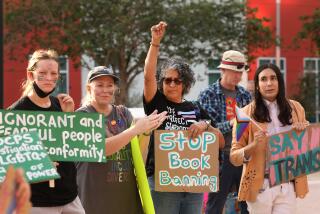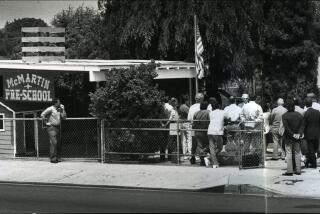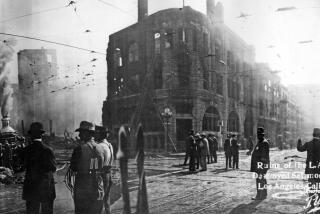Labor’s Love Lost : THE PEOPLE VS. CLARENCE DARROW: The Bribery Trial of America’s Greatest Lawyer, <i> By Geoffrey Cowan (Times Books: $27.50; 546 pp.)</i>
Clarence Darrow, now remembered mostly as the hero of the Scopes “Monkey” trial, dramatized in “Inherit the Wind,” was famous in his own day as labor’s lawyer. In 1911, after defending the McNamara brothers, union men who had bombed the Los Angeles Times building, he himself was tried for attempting to bribe a juror. Prof. Geoffrey Cowan, who says Darrow was a hero of his youth, has found much new material, if not much actual evidence, and has made up his mind that Darrow was guilty. To understand how Darrow could have done such a thing, he has tried to understand--and to make us understand--the context in which it was done. This makes the book more interesting and valuable than it might have been.
At the center of the tale is the Bridge and Structural Iron Workers Union. Times were hard, and construction firms avoided the union, cut wages and hired non-union workers, or subcontracted to non-union outfits. Finding that they were losing ground, in 1908, the Iron Workers began to plant bombs on construction sites where non-union workers were employed. This worked very well for a time. After 70 bombings, from 1908 to 1911, the Iron Workers had moved from being one of the lowest to one of the highest paid building trades.
There is not the slightest doubt about the bombings. Cowan, for all his sympathy for the union, sees no sign that state and federal prosecutors fabricated evidence: the Iron Workers had simply become a protection racket. But the union was a member of the American Federation of Labor, and in 1911, when the prosecutions of the union leadership began, Samuel Gompers, head of the AFL, sprang to their defense.
Gompers’ advocacy signaled a general mobilization of organized labor. The relatively conservative and well-established AFL was joined by the newer, immigrant-based, industrial unions under the banner of the Industrial Workers of the World; the Socialist unions, and the Socialist Party, led by Eugene Debs; and by the anarchist leader Emma Goldman (whom Cowan oddly does not mention). The violently warring factions of organized labor and left-wing politics for a moment combined in a great proletarian movement--fused by the electric charge of the prosecution of the Iron Workers.
The first to be arrested, John J. McNamara, was president of the Iron Workers, a handsome and able man who seems to have been utterly callous. He had directed the bombing campaign. His principal agent was his trusted younger brother, Jim, who was passionate where John was cold. Jim--pale, thin, chain-smoking--was an idealist, half in love with martyrdom.
The elder McNamara sent young Jim to bomb the Times building. But it was ineptly done. Jim put the bomb--a bundle of dynamite sticks wired to an alarm clock--beside some barrels of ink for the presses, and the explosion and fire which followed, instead of sending a modest warning, destroyed the building and killed 27 people. The hapless Jim was the first of the conspirators to be put on trial for the multiple murders.
Enter Clarence Darrow. He had worked for Gompers before, and had defended Debs, as well as Big Bill Haywood and other founders of the IWW, who were acquitted of murder-by-dynamite charges in 1907. Darrow was then 54, and as Cowan draws him, a bleak and burned-out man. The portrait is carefully constructed and persuasive. Darrow’s very success had left him cynical and reckless. But he didn’t want to take the McNamara case--he confided to a reporter that he thought the McNamaras were guilty and that the evidence collected by the William J. Burns agency was too damning. But Gompers insisted, and Darrow yielded.
Cowan carefully explores the pressure Gompers could apply, and the lure of an immense fee--$50,000 to be paid in advance. But he passes rather lightly over the question of Gompers’ motives. Gompers (and Debs) later claimed that they had been innocently deceived by the McNamaras, and that they had mounted a national defense in complete ignorance of the facts of the case. Cowan accepts these assertions, and does not ask us to wonder, if they were true, why then Darrow was not able to communicate his own reservations about the case.
Darrow in any case was persuaded to defend the McNamaras, and to present the theory that the Iron Workers had been framed. The now-familiar machinery of a national defense fund began to turn: rallies and marches, relentless repetitions of “frame-up” in the sympathetic press, buttons and stickers, boycotts and protests. Gompers and Debs campaigned systematically for the defense, constantly repeating the charge of “frame-up” and Debs seemed to threaten violence, a wave of “white rage” that would sweep the continent if the McNamaras were to be convicted. Public opinion swung heavily toward the defendants. In Indiana, at union headquarters, complaisant state prosecutors began returning to union officials the evidence the Burns agents had found. The prosecution of the union leadership would have collapsed, leaving Jim McNamara as a solitary martyr to the labor cause, if President William Howard Taft had not intervened. Taft, whose presidency was in the balance, knew that he was injuring it further by taking sides in a labor dispute.
But Los Angeles district attorney John Fredericks, prosecutor of Jim McNamara, set up a sting and caught the defense team investigators trying to bribe a prospective juror. Abruptly the defense in Jim McNamara’s case, and labor’s campaign for the Iron Workers, collapsed. Darrow, working very quickly, before the AFL leadership could be consulted, forced both the McNamara brothers to enter guilty pleas, and so doomed the strategy that had bound together the labor movement and the Socialist Party. Darrow’s motives were complex, but Cowan gives persuasive evidence that the hasty guilty pleas were engineered at least in part by Darrow to cut off the continuing investigation of which he was now a target.
Was Darrow guilty of the bribery attempt that backfired so disastrously? Perhaps. Cowan has found a great deal of new material, including the papers of Mary Field, Darrow’s mistress, but he has not found any new evidence that Darrow directed the bribe attempt. Cowan relies, as the prosecutors did, on evidence of a whole pattern of offenses by the defense team--suborning perjury, bribing jurors, intimidating, even attempting to kidnap, witnesses.
The evidence of abuses on both sides is strong. It was a hard fought and dirty contest. But the McNamara defense was to some extent managed by the AFL, who were paying the bills, and the investigators apparently were getting cash and perhaps instructions directly from headquarters. Cowan is a little too eager to sacrifice Darrow to the labor cause. The ultimate target of the bribery investigation seems to have been Samuel Gompers, and at one point Darrow agreed to plead guilty and give testimony against Gompers, to avoid a jail term. Cowan passes by this curious fact in silence.
Darrow’s plea offer was not accepted, apparently because he was not willing or able to give enough evidence against Gompers to satisfy the prosecution. The trial of Clarence Darrow on the bribery charge, which followed, was one of the great dramas in our legal literature. Darrow shared in his own defense. Cowan has rendered the trial beautifully, and Darrow’s defense and masterly summation is shown to be one of the great artistic triumphs of the law. He defended himself, he defended organized labor, he defended the bribery attempt and even the bombing itself. He was the martyr-savior of labor.
Yet Darrow after all had avoided martyrdom: He was acquitted of the bribery charge. But the leaders of organized labor never forgave him for saving himself. The brief alliance between Gompers and Debs disintegrated; Goldman and the more militant Wobblies and Communists damned them both. The moment of unity passed, and we will never know what might have come of it, if Darrow had been more like Jim McNamara, and less like John.
More to Read
Sign up for our Book Club newsletter
Get the latest news, events and more from the Los Angeles Times Book Club, and help us get L.A. reading and talking.
You may occasionally receive promotional content from the Los Angeles Times.







